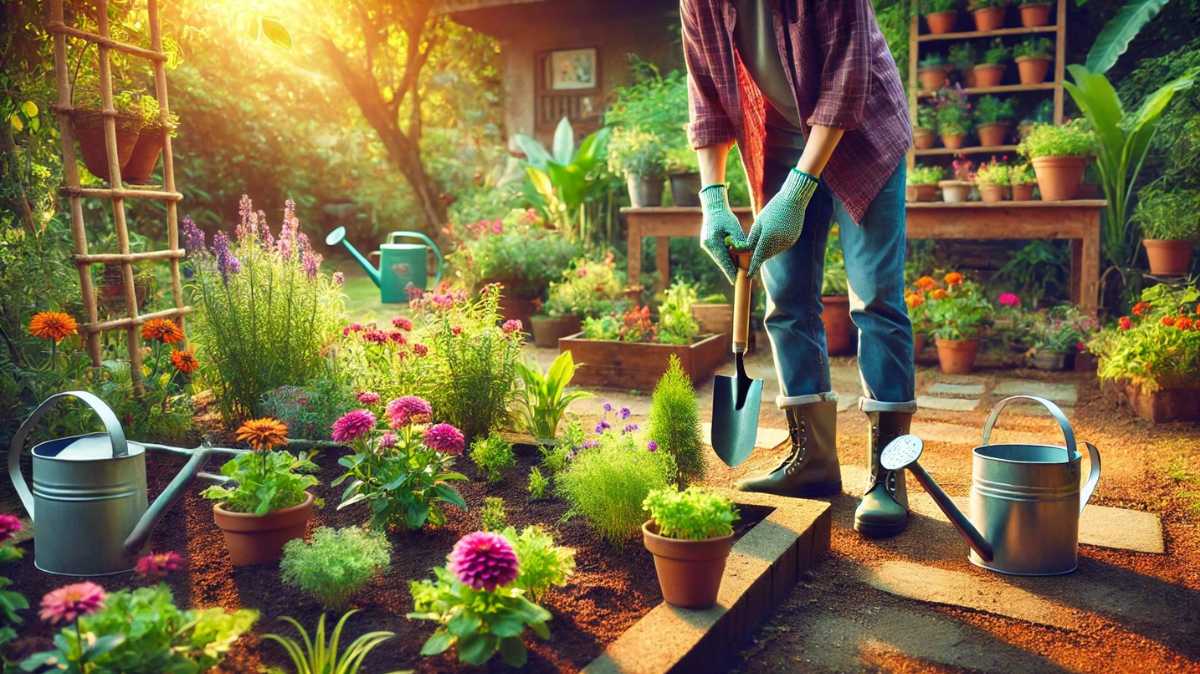Starting a garden as a beginner can feel intimidating. From selecting the right plants to ensuring proper care, there’s a lot to learn. This guide is designed to simplify the process, merging the best advice from experienced gardeners. By focusing on essential steps, you’ll transform your backyard into a thriving, beautiful oasis.
Table of Contents
1. Decide What You’d Like to Grow
The first step to gardening success is determining what plants you want to grow. Whether it’s vegetables, herbs, or flowers, your choice will guide how you set up the garden. Consider factors like:
- Edibility: Do you want fresh, home-grown produce? For a list of easy vegetables to grow, check out Better Homes & Gardens.
- Aesthetics: Are you aiming for vibrant flower beds?
- Local climate: Are the plants you love suited to your growing zone? Use the USDA Plant Hardiness Zone Map to find your zone here.
For beginners, herbs like basil and mint, or vegetables like tomatoes and lettuce, are easy to maintain and rewarding.
2. Choose the Ideal Garden Location
Location is key to a thriving garden. Different plants require different conditions, but for most, six to eight hours of sunlight is critical.
- South-facing spots tend to offer the best exposure to sunlight.
- Avoid areas prone to flooding or spots with poor drainage. To learn more about the best garden locations, visit The Royal Horticultural Society.
- For limited space, consider container gardening. Raised beds or vertical planters can make the most of small yards or patios, ensuring that even small gardens flourish.
3. Plan Your Garden Layout
Before planting, map out your garden. Consider grouping plants by type and growth requirements:
- Vegetables: Keep taller crops like corn or tomatoes at the north end to avoid shading shorter plants.
- Companion planting: Growing compatible plants together can boost growth. For example, basil enhances the flavor of tomatoes and deters pests. Learn more about companion planting from The Old Farmer’s Almanac.
This strategy ensures optimal space usage and helps maintain plant health by preventing overcrowding.
4. Invest in Basic Gardening Tools
A few essential tools make gardening much more manageable:
- Trowel: Ideal for digging small holes for seeds and transplants.
- Gloves: Protect your hands while working with soil or thorny plants.
- Pruners: Necessary for trimming plants and cutting away dead growth.
- Watering can or hose: Ensure your plants receive a consistent supply of water.
When buying tools, invest in quality items that will last for multiple seasons. Check out expert tool recommendations at Gardener’s Supply Company.
5. Test and Prepare Your Soil
Healthy soil is fundamental to plant growth. First, conduct a soil test to determine its pH and nutrient composition. You can purchase a DIY kit or send a sample to your local agricultural extension office, such as those found via The National Institute of Food and Agriculture.
- Sandy soil drains quickly and may need organic material for retention.
- Clay soil retains moisture but can become compacted.
- Consider enriching the soil with compost or organic matter to provide vital nutrients like nitrogen and phosphorus.
A well-prepared soil bed gives your plants the foundation they need to thrive.
6. Start with Great Soil and Compost
Healthy, rich soil is the cornerstone of any successful garden. Once you know your soil’s characteristics, you can enhance it:
- Compost: Adds organic matter, promoting beneficial microorganisms and improving structure. Learn how to make your own compost from The EPA’s Guide to Composting.
- Mulch: Helps retain moisture and suppress weeds. Organic mulches like straw or bark break down and contribute to soil health over time.
Creating or purchasing a good-quality compost bin is a smart way to ensure you always have nutrient-rich soil.
7. Choose the Right Seeds or Transplants
When picking plants, make sure they’re suitable for your climate zone. Some regions have short growing seasons, so choose varieties that mature quickly if necessary.
- Seeds: More affordable but require longer growing times.
- Transplants: Provide a head start, especially for longer-season crops like tomatoes or peppers.
To ensure success, use a mix of both—seeds for faster-growing crops like radishes, and transplants for plants needing a longer period to mature. Visit Seed Savers Exchange here to learn more about heirloom seeds.
8. Master Planting Techniques
Planting involves more than just placing seeds in the soil:
- Spacing: Avoid overcrowding. Proper spacing allows air to circulate, reducing the risk of disease.
- Depth: Check the seed packet or plant label for the recommended depth.
- Timing: Sow seeds at the right time of year. Early spring is ideal for cool-weather crops like lettuce, while summer heat is best for tomatoes.
A well-planted garden sets the stage for healthy growth.
9. Watering Your Garden Properly
Watering may seem straightforward, but there’s an art to it:
- Water deeply but infrequently: It’s better to water thoroughly once or twice a week rather than lightly every day. For a comprehensive guide, visit The University of California Agriculture & Natural Resources.
- Water in the morning: Early watering reduces evaporation and allows plants to absorb moisture before the heat of the day.
- Avoid wetting foliage: This helps prevent diseases, especially in humid climates.
Drip irrigation systems or soaker hoses are excellent options for consistent, water-saving methods.
10. Stay On Top of Weeding and Maintenance
Regular maintenance is essential to keeping your garden healthy.
- Weed control: Pull weeds when they’re small to prevent them from competing for water and nutrients.
- Pruning: Remove dead or diseased foliage to encourage new growth.
- Fertilize: Use organic or slow-release fertilizers to nourish your plants without overwhelming them. For expert guidance on organic fertilizers, visit Rodale Institute.
Frequent attention to these small tasks will lead to a lush, thriving garden.
FAQs
What should I plant first as a beginner?
Start with easy-to-grow plants like herbs (basil, mint), vegetables (lettuce, tomatoes), or hardy flowers like marigolds. These plants are forgiving and provide quick results.
How much sunlight does my garden need?
Most plants need 6–8 hours of direct sunlight each day. However, some leafy greens like spinach or kale can tolerate partial shade.
How often should I water my plants?
Water deeply once or twice a week, depending on your climate. Make sure the top inch of soil dries out between watering sessions.
Can I grow plants in containers?
Yes, container gardening is great for small spaces. Ensure your containers have drainage holes and are filled with nutrient-rich soil.
How do I make my soil fertile?
Use compost and organic fertilizers to improve your soil’s nutrient content. Adding mulch also helps retain moisture and reduce weeds.
What is companion planting?
Companion planting is growing plants together that benefit each other. For example, planting marigolds with tomatoes can repel pests.
Final Thoughts
Gardening for beginners doesn’t have to be overwhelming. By focusing on location, soil, and plant care, you’ll set yourself up for success. Stay consistent with maintenance, and soon you’ll enjoy the beauty and rewards of your home garden. For more in-depth tips, consult reliable gardening resources such as The Old Farmer’s Almanac or your local extension service.
Author

An aspiring business leader, I am working towards my dream of graduating from Stanford University with a degree in Business Management. Passionate about sharing knowledge, I strive to empower others through education and collaborative learning.
View all posts


